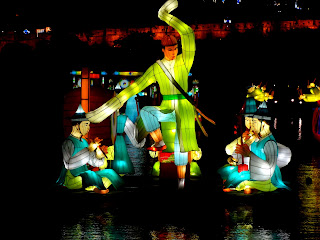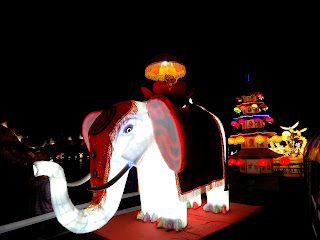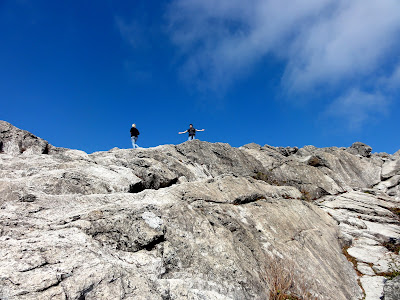Being free from KELI again - Seoul
(lk) Als Abschluss unserer kleinen Serie "Wir sind international und sprechen Englisch" folgt nun der Abschluss unseres Chuseok-Urlaubs. Carsons und mein Trip nach Seoul. Susan und Mai-Linh konnten uns leider nicht in die Hauptstadt Südkoreas begleiten, die Uni schiebt ab und an recht kurzfristig Klausuren und andere Dinge in den Alltag. So sind Carson und ich zu zweit in die Metropole am Han (das ist der Fluss der durch Seoul fließt) gegangen. Nachfolgend nun die Beschreibung einer kleinen Episode die wir dort erlebt haben - mit Hintergrundanalyse - und dann noch einige andere Eindrücke.
Die Insadong-gil in Seoul (gil bedeutet Straße). Wie man sieht generell sehr gut besucht und natürlich auch ein sehr beliebtes Ziel für Touristen. Viel Leben, viele Cafés und Kunstgalerien finden sich in dieser Straße.
With a friend of mine, I
visited Seoul one month ago. In the attempt to get a rough overview of the
city, we did not hesitate to visit some of the rather touristy sights. So, one
afternoon, we found ourselves standing in the middle of the famous Insadong-gil. The place was absolutely crowded, but
still the atmosphere was very nice walking along the cafés, small shops and art
galleries. Later on, we found a group of Korean schoolgirls, standing at the
side of the street. As they saw us – easily identifiable as foreigners - they
approached us and asked us to take part in a small quiz. We answered some
questions on South Korea (What is the capital and so on) and in the end, as a
prize, got some candies. Such quizzes by students can frequently be seen here
in Korea. However, at this day in Insadong-gil, the quiz had a rather
interesting feature. As the quiz was over, one of the girls – maybe 14 years
old – asked us with an impressive level of English: “Have you heard about
Dok-do.” We said yes. The girl went on to explain that Dok-do was an island in
the sea between Japan and South Korea and that both states claim the island to
be theirs. She finished by saying: “Please keep in mind, Dok-do is Korean
territory.” This occurrence left me intrigued.
Nochmal Insadong-gil, ein kleines Video. Wieder einmal entschuldige ich mich für die doofen Streifen im Bild.
As a German I cannot think of German pupils going on the
street and telling non-Germans that the German government hands too much of its
power to the EU. Or may it be some other political issue; the commitment of
these schoolgirls in Seoul simply fascinated me. I don’t know if this quiz was
a regular school activity or if the students did it during their spare time.
Either way, they didn’t seem to be uncomfortable with their task. Did we
encounter 14 year old school girls who were so angry about the Japanese points
for claiming Dok-do as their territory that they just had to go on the street?
When they told us that Dok-do is Korean territory, did they base their
statement on a broad study of the history of the island? Of course this is
possible, but it seems to be more reasonable to see these girls behaviour
against the background of the very emotional relationship between Korea and
Japan. If you ask yourself, why this relationship is so tense, you can study
the history of Korean-Japanese relations. Once in Insadong-gil you instead have
the option to walk 500 meters to the Gyeongbokgung, one of the five palaces in
Seoul.
Zwischen
Korea und Japan herrscht seit Jahrzehnten ein Streit um territoriale Ansprüche.
Die Felsformation Dok-do (koreanischer Name) bzw. Takeshima (japanischer Name) in den Gewässern zwischen Japan und Korea
wird von beiden Staaten beansprucht. Das Meer, in dem diese kleinen felsigen
Eilande liegen wird von den Japanern übrigens Japanisches Meer genannt, von den
Koreanern hingegen Ostmeer.
A short look at the history of this
palace can help you understand, why you can find schoolgirls in Seoul,
explaining you that Dok-do does not belong to Japan. Gyeongbokgung is located in central Seoul. In this area, five
palace complexes can be found. According to the brochure I got there, the name
Gyeonbokgung can be translated as “Palace Greatly Blessed by Heaven”. The
location couldn’t be more central. Today, the American embassy is right around
the corner. The statues of King Sejong the Great (he ordered the invention of
an own Korean phonetic script, known as the Hangeul) and Admiral Yi (he fought
against the Japanese in the 16th century)
are located on the street running south from the palace entrance. To the north
of the palace, the mountain Bugaksam makes the appearance all the more
beautiful. But not only the location of this palace is extraordinary. It was
built in 1395 right after the founding of the Joseon Dynasty. From the
beginning it was the main palace for this dynasty and was a symbol of power for
the kings of Joseon. Over the years, the complex of buildings steadily
expanded. Around 1553, a fire destroyed large parts of the palace complex,
though the buildings were restored soon after.
Der Haupteingang des Gyeonbukgung Palastes in Seoul. Im Hintergrund sieht man die Stadt, die die umfangreiche Palastanlage einschließt.
Der Hauptthronsaal
Im Norden des Palastes beginnt
ein malerischer Höhenzug.
However in 1592, we have to introduce
a new element to the history of this sight, and this element brings us back to
where we started: Schoolgirls in the Insadong-gil in Seoul emphasizing the
Korean property of Dok-do. In 1592, Japan starts it invasion of Korea. For
seven years Japan tried to conquer the kingdom of Joseon.
In the end the Japanese failed, however they managed to destroy large parts of
the country. In 1592, Japanese troops also came to Seoul and destroyed
Gyeongbokgung. As you remember, in the years after 1553 the palace had just
been rebuilt in the wake of a fire. But in the end it was for nothing, as the Japanese would
destroy it again. Since the middle of the 16th century “Palace Greatly Blessed by
Heaven” was no longer a fitting name for this palace.
But
again, the “Palace Greatly Blessed by Heaven” could not keep the promises made
by its name. In 1895 the wife of King Gojong – 26th king of the Joseon
Dynasty – was murdered in Gyeongbokgung. Her name was Myeongseong, also
referred to as Queen Min. She was one of the members of the Korean royal court
who opposed the Japanese expansion the most, leading to her assassination in
1895 by Japanese agents. After this incident the royal family never returned to
the palace Gyeongbokgung. In 1910, Korea was annexed by Japan and starting in
1915, the palace was once again torn down by Japanese forces. Around 90 percent
of the buildings were dismantled during the Japanese reign in Korea. After
the end of the Korean War, it took until 1990 to start the restoration of this
historic sight. For the second time in history, the Koreans were rebuilding
what the Japanese had torn down. Today, only around 40 percent of the once
existing buildings have been restored.
Parts
of the palace’s history can still be seen today. When you enter the gate, you
find yourself in a very large complex of buildings. Although, everything is
new, the oldest parts are around 150 years old. Not much for a palace which was
built in 1395. You can see wide fields where restoration is still going on and
not finished yet.
Palastwachen und Koreanerinnen
beim Posieren. Der Bart ist nicht echt.
Each day the guards at the large gate
in the south – the Gwanghwamun – are changing several times, performing a
sophisticated ceremony thereby. But what are they taking care of? Their fancy dresses and their fake Korean beards gave me an odd impression. As there are no
Korean monarchs anymore and the Gyeongbokgung had been destroyed several times,
the palace should rather be seen as a symbol for the tragic parts of the
history of Joseon Korea. But the guards are doing their daily routine -
entertaining the masses of tourists. At its heart, one could say these pseudo
Joseon soldiers take care of a sight whose history was rather written by Japan,
than by Korea.
After seeing this place I had to think of the
schoolgirls in the Insadong-gil. I tried to think of the some European
country doing the same as Japan did to the Gyeongbokgung palace with an
important German historical sight. Maybe the Korean schoolgirls did not know
anything about the history of Gyeongbokgung. But when you consider that this
was only the history of a palace and that there must have been much more the
Japanese did to the Koreans, their behaviour seemed to me more understandable.
The resentment of the Koreans towards Japanese is rooted in history, just as the
history of the Gyeonbokgung.
In der Nähe des Palastes befindet sich ein Statue König Sejongs. Er war maßgeblich an der Erfindung des heute verwendeten koreanischen Schriftsystems Hangeul beteiligt, wenn vielleicht auch nur als Strippenzieher, der die richtigen Leute zusammenbrachte. Die Schriftzeichen auf dem Sockel sind zu lesen als: "Sejong Daeoang" = König Sejong.
Christentum hat hier viel mehr zu bieten als bei uns :-) Und ist auch überall anzutreffen. Wir haben hier Stände von irgendwelchen Christen angetroffen, an denen vor den Gefahren der Hölle gewarnt wird und in der U-Bahn kann einem auch schon mal ein netter alter Herr mit der aufgeschlagenen Bibel entgegen kommen.

Mittagspause in Seoul. Um diese Zeit füllen sich die Straßen mit Männern und Frauen in schwarzer Büromontur. Hier steht man bei einem Coffeeshop an. Detail: Der Mann ganz rechts telefoniert und massiert dabei dem Kollegen vor ihm den Nacken.
Eine Kampfkunstshow mit viel Elan.
In der Garage steht ein Volvo.
Eines der vielen Hähnchenrestaurants in Korea. Frittiertes Hähnchen ist ein integraler Bestandteil der Esskultur hier, der jungen versteht sich. Abends im Wohnheim greift man skrupellos auf den Chicken-Lieferservice zurück oder geht ins Restaurant wie hier in Seoul. Detail: nix Messer und Gabel, zwei Gabeln sind oftmals das Werkzeug der Wahl.
Gangnam bei Nacht. Das ist er also, der Stadtteil der in PSYs Gangnam Style besungen wird. Es ist dort hell und lebendig, alles ist neu und modern, ein Viertel mit vielen neuen Hochhäusern und viel Geld. "Gangnam" bedeutet wörtlich übersetzt soviel wie "Südlich des Flusses" (meine ich zumindest). Das Viertel ist darum recht leicht auf einem Stadtplan von Seoul zu finden, nämlich südlich des Han-Flusses.
Mit Ozan, einem Türken der gerade in Shanghai studiert, waren wir zwei Tage unterwegs. Hier in einer Bar in Gangnam, in der Makgeolli serviert wird. Das ist koreanischer Reiswein und schmeckt meiner Meinung nach etwa so wie Apfelwein. Sehr erfrischend.
Als Beilage gab es Äpfel mit
Mayonaise und Larven.
Last but not least: ein gütiges Schicksal wollte es, dass Carson und ich doch tatsächlich zu dem Zeitpunkt in Seoul waren, als PSY ein Gratiskonzert in der Innenstadt gab. 80.000 Leute, zwei Stunden Liveshow, alles umsonst, was will man mehr. Hier ein kleiner Ausschnitt des wichtigsten Momentes



































































